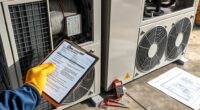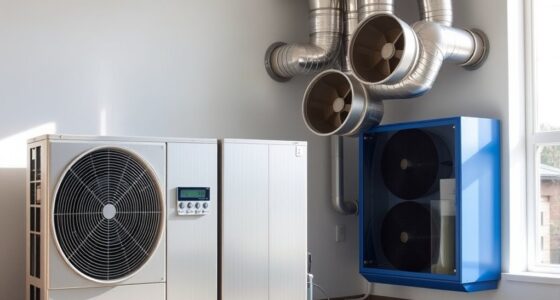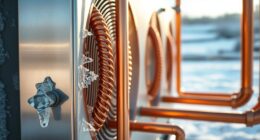If you’re comparing split, multi-split, and packaged heat pump systems, you’ll find that split systems have separate indoor and outdoor units, ideal for smaller spaces. Multi-split units connect multiple indoor zones to one outdoor unit, offering better zoning, while packaged units combine everything in one outdoor unit, saving indoor space. Each has different installation needs, costs, and efficiency. To see which fits your home or business best, continue exploring their features and benefits.
Key Takeaways
- Split systems have separate indoor and outdoor units, ideal for smaller spaces with limited zoning needs.
- Multi-split systems connect multiple indoor units to one outdoor unit, offering flexible zoning for larger or multi-zone buildings.
- Packaged heat pumps combine all components in a single outdoor unit, saving indoor space but potentially producing more noise.
- Installation complexity varies: split systems are simpler, multi-split requires more planning, and packaged units are straightforward but need outdoor space.
- Cost, efficiency, and maintenance needs differ, with split systems generally being more affordable and easier to maintain than multi-split and packaged options.
Overview of Heat Pump System Types
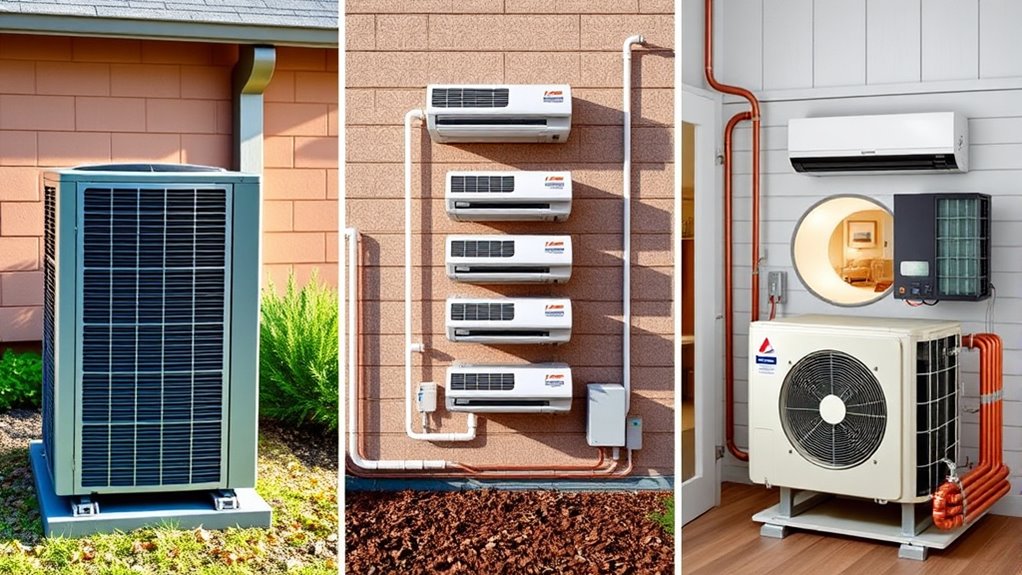
Heat pump systems come in various configurations, each designed to meet different heating and cooling needs. When choosing a system, consider how well it integrates aesthetically into your space. Some models feature sleek designs that blend seamlessly with your home’s decor, reducing visual clutter. Noise levels also play a crucial role; quieter units ensure your comfort without disturbance. Split systems, for example, typically have outdoor and indoor components, allowing flexible placement that minimizes noise inside. Packaged units consolidate all components into one cabinet, often designed for quieter operation. Multi-split systems offer multiple indoor units connected to a single outdoor unit, providing aesthetic flexibility and noise control. Understanding these configurations helps you select a system that balances aesthetic appeal and quiet operation for your specific environment. Additionally, choosing a properly maintained heat pump can ensure optimal performance and longevity of the system.
Design and Configuration Differences
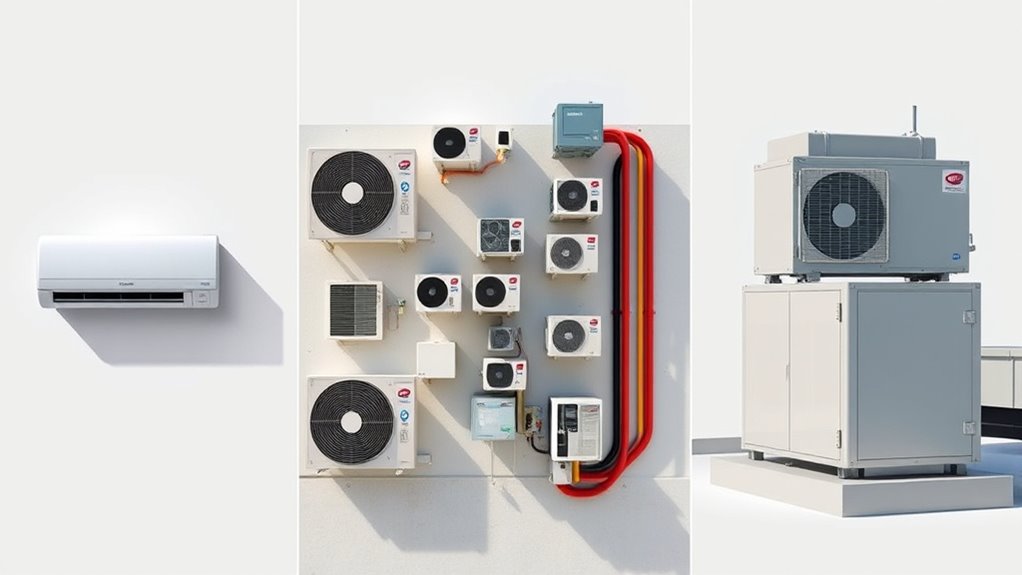
Different configurations of heat pump systems are designed to suit various space requirements and installation preferences. Split systems typically feature an outdoor unit connected to one or more indoor units, offering flexibility but facing zoning limitations if multiple zones are needed. Multi-split systems expand on this by allowing several indoor units to connect to a single outdoor unit, helping overcome zoning constraints and improving comfort control. Packaged systems combine all components into one unit, often installed outdoors, reducing indoor space but sometimes impacting aesthetic appeal. The choice depends on your space layout and aesthetic priorities. Understanding these design differences helps you select a system that balances zoning capabilities with visual impact, ensuring ideal performance aligned with your preferences. Additionally, selecting the right system can benefit from knowledge of system efficiency and how it impacts overall energy consumption.
Installation and Space Requirements
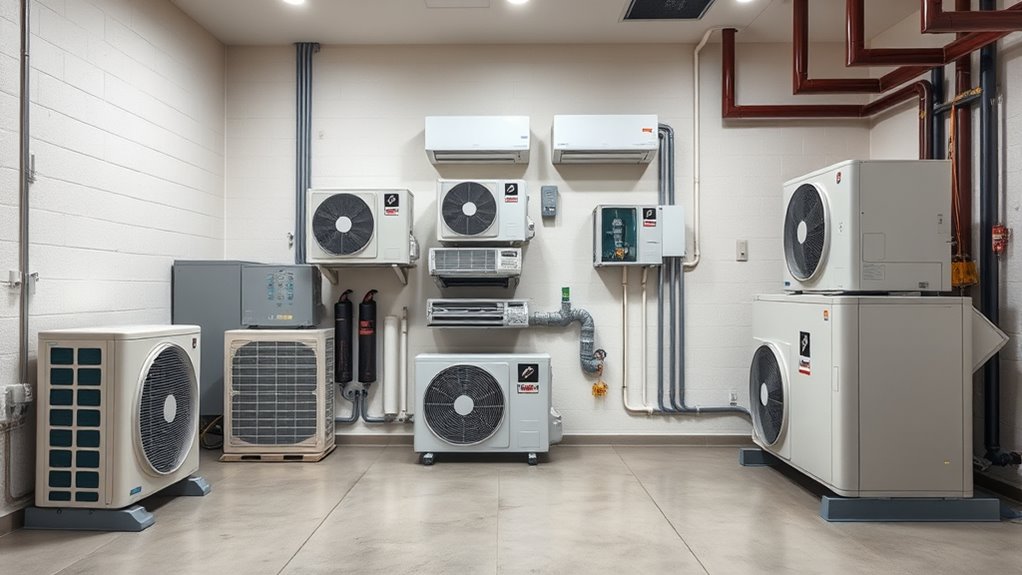
When selecting a heat pump system, you need to take into account the space available for installation and how much room each option requires. Different systems vary in installation complexity and footprint, affecting where they can be placed. Understanding these space needs helps guarantee a smooth setup and ideal performance. Additionally, considering the size of the space and the system’s heating capacity is essential to ensure efficient operation and comfort.
Space Needs for Split
Installing a split heat pump system requires careful consideration of space, both indoors and outdoors. The outdoor unit typically has a compact footprint, allowing it to fit comfortably on a balcony, patio, or near a wall. Indoors, the air handler or evaporator unit needs sufficient space for proper airflow and maintenance access. Its slim design helps maximize indoor space, making it suitable for smaller rooms or tight areas. You should ensure there’s enough clearance around the indoor unit to facilitate efficient operation and easy servicing. Proper placement guarantees ideal performance and longevity of the system. Additionally, understanding cost and budgeting considerations can help you plan effectively for installation expenses and future upgrades. Overall, split systems are designed to minimize space requirements, making them ideal for homes with limited indoor or outdoor space. Proper placement guarantees ideal performance and longevity of the system.
Installation Complexity Variances
The complexity of installing a split heat pump system can vary considerably based on space and site conditions. You might face challenges like:
- Ductwork modifications needed to guarantee proper airflow.
- Finding suitable outdoor unit placement with adequate clearance.
- Steering limited space for indoor unit installation.
- Managing electrical and refrigerant line runs between indoor and outdoor units.
- Proper planning for remote work and equipment setup can influence installation efficiency and safety.
Each factor influences installation time and effort. For example, tight spaces may require custom ductwork, increasing complexity. Outdoor unit placement demands careful planning to avoid obstructions and guarantee efficient operation. These variances mean you should assess your site carefully to determine the best setup, especially when considering ease of access, safety, and future maintenance. Being aware of these factors helps streamline installation and avoid surprises.
Packaged System Footprint
Have you considered how much space a packaged heat pump system requires? These units are designed to be compact, often installed outdoors, saving indoor space. Their footprint is generally smaller than split systems because all components are housed in a single cabinet. This can improve system aesthetics by reducing clutter and maintaining a cleaner look around your property. Additionally, installation considerations such as accessibility and local climate can influence the suitability of a packaged system for your needs. However, you’ll need to ensure there’s enough clearance around the unit for proper airflow and maintenance. Noise levels are another consideration; packaged systems tend to be louder than split units due to their outdoor placement, but modern designs incorporate noise-reduction features. Overall, their footprint makes them ideal for limited spaces, but balancing aesthetics, noise, and space requirements is key to choosing the right system for your needs.
Cost Analysis and Budget Considerations
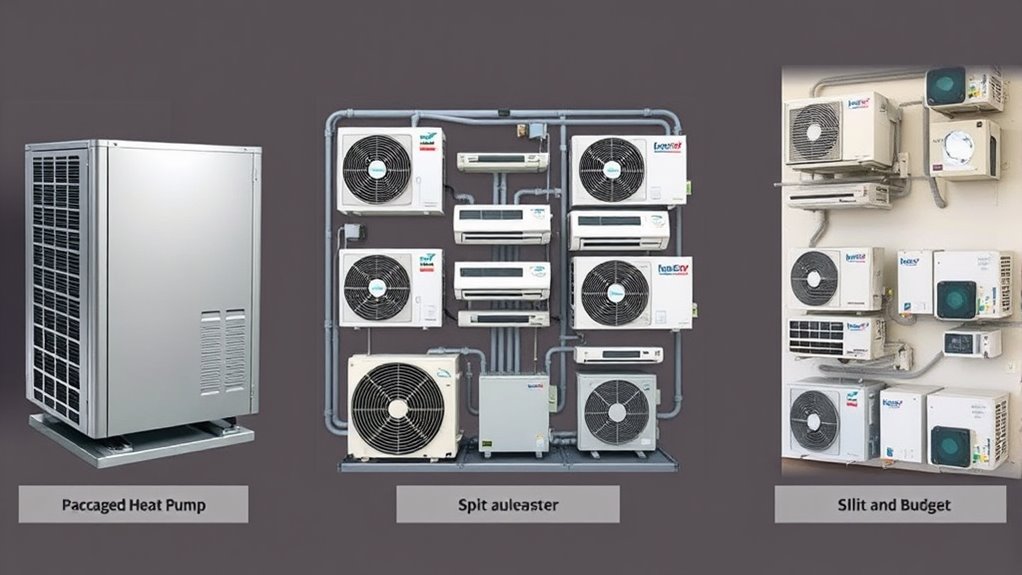
When evaluating different heat pump systems, understanding the cost implications is essential for making an informed decision. Your budget should consider initial installation costs and long-term maintenance. Here are key points to keep in mind:
- Initial installation costs vary considerably: split systems are usually less expensive upfront, while multi‑split and packaged systems may cost more due to complexity.
- Long-term maintenance expenses depend on system type; simpler units often have lower upkeep costs.
- Consider potential upgrades or modifications that might increase costs later.
- Budget for possible repair expenses associated with each system’s design and components.
- Incorporating preventive maintenance can help reduce long-term costs and improve system reliability.
Energy Efficiency and Operating Costs
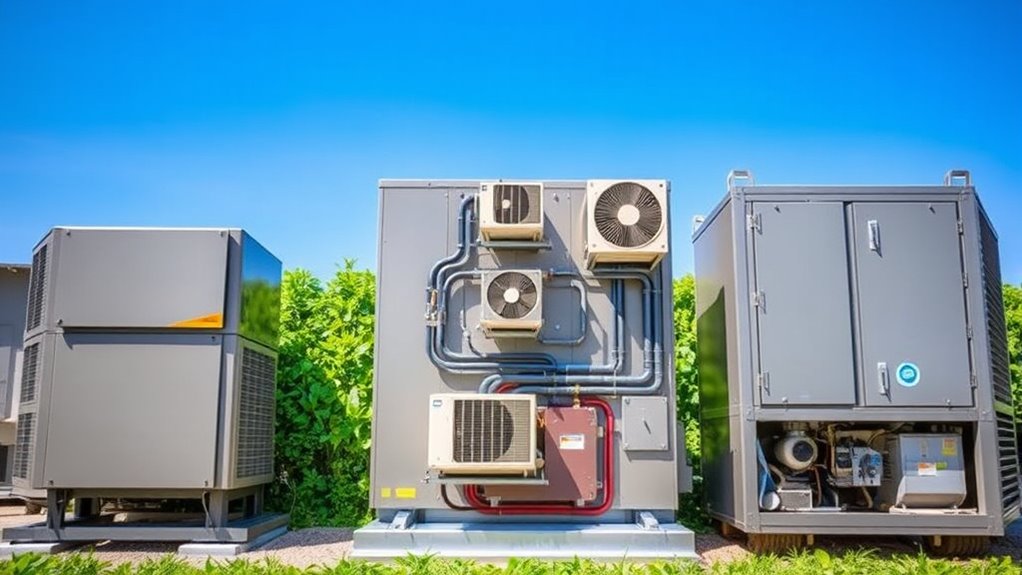
Choosing a heat pump system with high energy efficiency can substantially lower your operating costs over time. When comparing systems, consider the cost comparison and potential energy savings. Split systems often provide better efficiency for smaller spaces, while multi-split setups can optimize energy use across multiple zones. Packaged systems tend to be less efficient but are easier to install. Here’s a quick comparison:
| System Type | Energy Efficiency | Operating Costs |
|---|---|---|
| Split | High, tailored to zone needs | Lower with proper sizing |
| Multi-split | Very high, flexible zoning | Potentially lower overall |
| Packaged | Moderate, simpler design | Slightly higher in some cases |
Choosing the right system depends on your energy goals and budget, ensuring ideal savings over time. Efficient system operation can also be enhanced through regular maintenance and the use of smart controls.
Suitability for Residential and Commercial Use
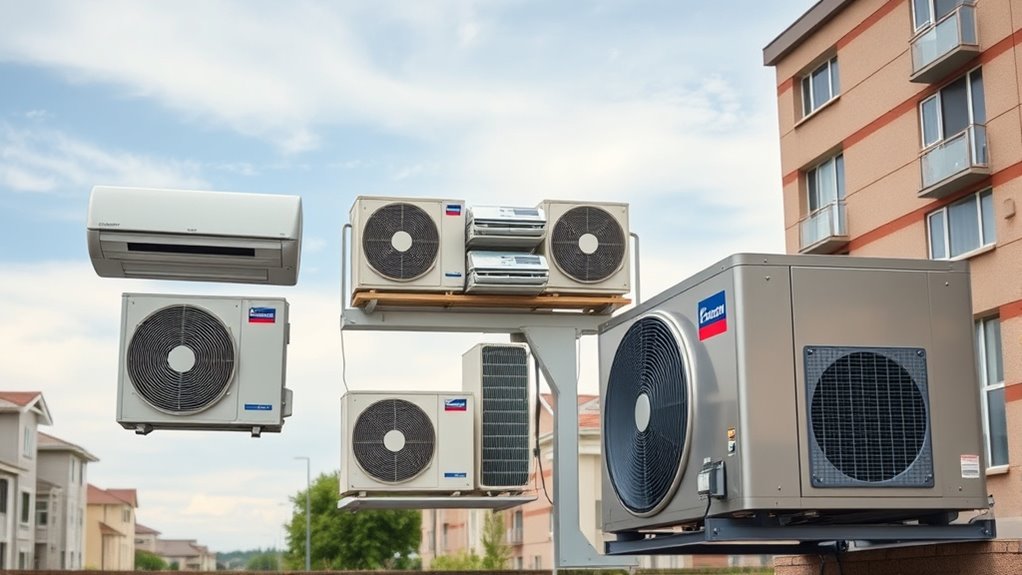
When choosing a heat pump system, you need to consider how well it fits your space, whether residential or commercial. Commercial applications often demand higher cooling efficiency, making some options more suitable than others. Additionally, installation complexity varies, so you should evaluate what’s manageable for your specific setup. For added confidence, verifying the trustworthiness of the brand can help ensure you select a reliable and effective system.
Residential Space Compatibility
Are split, multi-split, and packaged heat pump systems suitable for both residential and commercial spaces? Yes, but their suitability depends on your specific needs. For residential use, these systems can enhance indoor air quality and maintain comfort efficiently. However, consider these factors:
- Indoor Air Quality: Multi-split systems can improve air circulation and filtration, benefiting homes with allergy sufferers.
- Noise Levels: Packaged systems tend to be louder, which might affect your quiet living spaces.
- Space Constraints: Split systems are ideal for smaller homes, while packaged units suit larger, space-limited areas.
- Installation Flexibility: Multi-split setups offer customization for different rooms, making them adaptable to various residential layouts.
Choosing the right system guarantees comfort without compromising indoor air quality or noise considerations.
Commercial Cooling Efficiency
Commercial cooling systems are designed to deliver high efficiency and reliable performance in large-scale environments, making them suitable for both commercial and some residential applications. These systems typically offer superior cooling capacity and energy efficiency, helping you reduce operational costs. Noise levels are often optimized to minimize disruption, which is vital in settings where quiet operation matters. Additionally, their aesthetic integration is important; many commercial units are designed to blend seamlessly into different environments, maintaining visual appeal. For residential uses, this means choosing models that balance performance with unobtrusive design. Overall, commercial cooling systems excel in efficiency and reliability, making them versatile options for various applications where durability, quiet operation, and aesthetic considerations are key. Understanding market demand and how it influences design choices can further aid in selecting the most suitable system.
Installation Complexity
Installing split, multi-split, and packaged heat pump systems can vary considerably in complexity depending on the application. For residential use, split systems are usually simpler to install, with lower maintenance frequency and quieter operation. Multi-split systems require more planning due to multiple indoor units, increasing installation complexity. Packaged systems are often favored for commercial spaces because they consolidate components, but their size and ductwork can complicate setup. Here’s what influences installation:
- Number of indoor units and layout
- Space availability and accessibility
- Required electrical and ductwork modifications
- Noise level considerations for comfort and compliance
Understanding these factors helps determine the suitability for residential or commercial use, balancing installation effort with ongoing maintenance needs.
Choosing the Right System for Your Needs
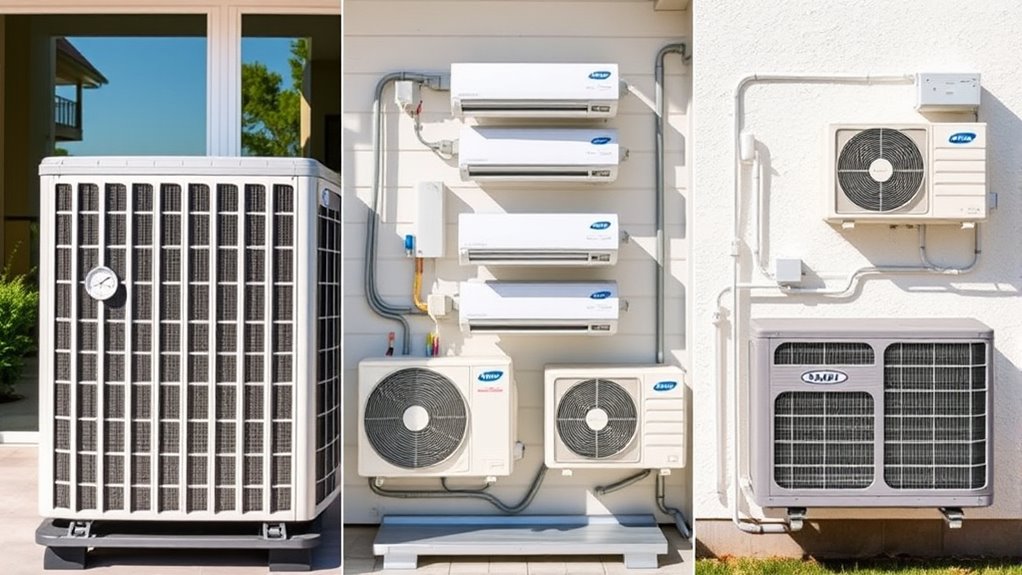
Choosing the right heat pump system depends on your specific heating and cooling needs, as well as the size and layout of your space. Consider factors like whether you want a simple diy installation or prefer professional setup. Also, evaluate maintenance requirements, since some systems need more upkeep than others. To help, here’s a comparison:
| System Type | Best for | Installation Ease | Maintenance Level |
|---|---|---|---|
| Split | Single-room, small to medium | Moderate, DIY possible | Moderate |
| Multi-split | Multiple zones, variable needs | Complex, professional | Moderate to high |
| Packaged | Small commercial or limited space | Easier, professional | Lower |
Knowing these details helps you choose a system that matches your comfort, budget, and technical skills.
Frequently Asked Questions
How Do Maintenance Requirements Vary Among the Different Heat Pump Systems?
You’ll find that maintenance requirements vary based on system type. Generally, you’ll need regular maintenance, like filter changes and coil cleaning, about twice a year. Technician accessibility influences how easily they can service your unit; split systems usually offer better access, while packaged units might be more challenging. Multi-split systems may require more frequent checks due to multiple components. Staying consistent with maintenance guarantees efficient operation and longer system life.
What Are the Environmental Impacts of Each Heat Pump Type?
Think of each heat pump type as a different eco-ship sailing through environmental waters. You’ll find that their environmental impacts vary: some face recycling challenges due to complex parts, while manufacturing emissions differ based on size and technology. Generally, smaller, simpler systems produce fewer emissions and are easier to recycle. You can reduce your footprint by choosing systems with better eco-designs, helping to navigate environmental challenges more smoothly.
Can These Systems Be Integrated With Renewable Energy Sources?
You can definitely integrate these heat pump systems with renewable energy sources, enhancing renewable integration. By connecting them to solar panels or wind turbines, you reduce reliance on traditional energy sources and lower your carbon footprint. This setup allows you to maximize energy efficiency, cut costs, and support sustainability. Proper planning and compatible equipment ensure seamless integration, enabling your system to harness renewable energy effectively and contribute to a greener environment.
How Do Noise Levels Compare Across Split, Multi-Split, and Packaged Units?
You might notice different sound levels and noise disturbance depending on the system you choose. Generally, split units operate quietly, often around 50-60 decibels, making them less disruptive. Multi-split systems also maintain low noise levels, but multiple indoor units can increase overall sound. Packaged units tend to be louder, sometimes exceeding 70 decibels, which could cause more noise disturbance. Your choice depends on your tolerance for noise and comfort needs.
Are There Specific Climate Conditions Best Suited for Each System Type?
Think of each system as a tailored suit; your climate adaptability determines which fits best. For hot, humid environments, split systems excel with easier installation and efficiency. Multi-split units work well when space is limited, handling diverse zones. Packaged units suit compact spaces and milder climates. Consider installation challenges and climate demands to choose the system that offers ideal comfort and energy savings for your specific conditions.
Conclusion
Choosing the right heat pump system depends on your space, budget, and efficiency goals. Did you know that multi-split systems can save up to 30% on energy costs compared to traditional setups? Whether you opt for a split, multi-split, or packaged unit, understanding their differences helps you make an informed decision. Investing in the right system can improve comfort and cut costs, so consider your needs carefully to find the perfect fit.

